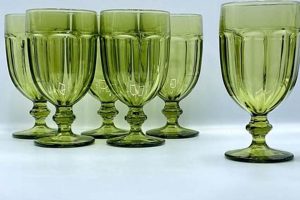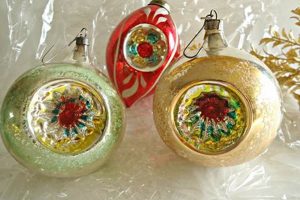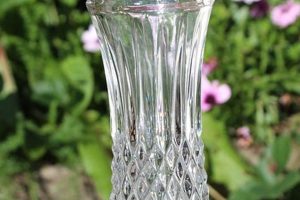These vessels, typically crafted before the modern era of mass production, represent a distinct era in glassmaking. Characterized by unique designs, hand-blown techniques, and often embellished with intricate detailing, they were frequently used for serving wine at formal dinners and special occasions. These items can range from delicate crystal goblets to sturdy, utilitarian drinking vessels, each reflecting the aesthetic preferences of its time.
Acquiring these antique items offers several advantages. Beyond their aesthetic appeal, these glasses serve as tangible links to the past, offering insights into historical drinking customs and artisanal craftsmanship. Their value often appreciates over time, making them attractive investments for collectors. Furthermore, using such glassware can elevate the sensory experience of wine consumption, enhancing both the visual presentation and perceived taste.
The following sections will delve into various aspects of collecting and appreciating these items, including identification techniques, common manufacturing periods, care and maintenance guidelines, and their place in historical dining practices. Further discussion will explore the impact on the value and collectability of these objects.
Tips for Identifying and Collecting Vintage Wine Glasses
Successful identification and preservation of these delicate historical objects requires diligence and knowledge. The following tips provide a framework for navigating the nuances of this specialized field.
Tip 1: Examine the Glass for Manufacturing Marks: Look closely for pontil marks (roughness on the base) or mold seams. Hand-blown glassware often lacks perfectly symmetrical seams, whereas mass-produced items exhibit more uniform lines. This differentiation can indicate age and production method.
Tip 2: Assess the Clarity and Composition: Older crystal frequently contains trace elements that can subtly tint the glass. Examine the clarity under natural light; a slight yellowing or graying may indicate age and a different composition than modern lead-free crystal.
Tip 3: Research Common Patterns and Makers: Familiarize yourself with known patterns from prominent manufacturers like Waterford, Baccarat, or Moser. Online resources and antique guides can assist in matching patterns and identifying potential makers.
Tip 4: Inspect for Signs of Wear and Damage: Minor scratches are expected on used glassware. However, significant chips, cracks, or cloudiness can diminish value. Prioritize pieces in the best possible condition relative to their age.
Tip 5: Consider the Stem and Base: The stem and base often exhibit distinctive design elements. Pay attention to the shape, thickness, and embellishments. Specific stem designs, such as baluster or knopped stems, are associated with particular periods.
Tip 6: Consult with Appraisers and Experts: For valuable or questionable pieces, seek professional appraisals. Experienced antique dealers or glassware specialists can provide accurate assessments of authenticity and value.
Tip 7: Document Purchases and Provenance: Keep records of acquisitions, including purchase dates, prices, and any available historical information. Provenance enhances collectibility and demonstrates the object’s history.
By implementing these strategies, collectors can make informed decisions, safeguard their investments, and deepen their appreciation for the artistry of vintage glassware.
The subsequent sections will explore the proper methods for cleaning and storing these fragile artifacts, ensuring their long-term preservation.
1. Craftsmanship
The value and appeal of these objects are inextricably linked to the craftsmanship employed in their creation. Glassmaking, prior to widespread automation, was a labor-intensive process that relied heavily on skilled artisans. Hand-blown techniques, evident in subtle imperfections and variations in form, stand in stark contrast to the uniformity of machine-made glassware. The presence of fine detailing, such as hand-cut facets, delicate engraving, or intricate enamel work, further underscores the dedication and artistry involved. Consequently, the level of craftsmanship directly influences the perceived quality, rarity, and, ultimately, the market value of such items.
Examining examples from different eras reveals the evolving nature of craftsmanship. For instance, Venetian glassmakers of the 17th and 18th centuries were renowned for their delicate, intricately decorated goblets, often featuring elaborate stems and colorful enamel designs. These pieces, prized for their artistic merit, command significant value in today’s antique market. In contrast, the rise of pressed glass techniques in the 19th century allowed for more affordable production, though at the expense of some artistic detail. Understanding these historical shifts in craftsmanship is crucial for accurate identification and appraisal.
Appreciating the role of craftsmanship offers practical benefits for collectors and enthusiasts. It enables informed purchasing decisions, allowing individuals to discern genuine examples of fine glassmaking from mass-produced imitations. It also fosters a deeper understanding of the historical context and cultural significance of these objects. The understanding of the craftsmanship used to make these objects allows for proper care and preservation methods, extending their lifespan and aesthetic appeal for future generations.
2. Material Composition
The material composition of antique glassware profoundly affects its durability, appearance, and historical significance. Early examples were often crafted from potash glass, prone to instability and characterized by a greenish tint due to impurities. Lead crystal, introduced later, offered increased brilliance, clarity, and workability, quickly becoming the preferred material for finer glassware. The inclusion of lead oxide also allowed for more intricate cutting and engraving, distinguishing quality examples. Consequently, determining the glass type offers clues about its age, origin, and intended use.
Different eras showcase distinctive material preferences. The prevalence of Bohemian glass, known for its high potash content and vibrant colors achieved through metallic oxides, marks a specific period. Conversely, the widespread adoption of lead crystal in English and Irish glass production during the 18th and 19th centuries resulted in heavier, more refractive pieces. Identifying these variations aids in authenticating and valuing glassware. Modern reproductions often lack the characteristic weight and refractive index of authentic lead crystal, making material analysis a critical tool for collectors and historians.
Understanding material composition is not merely an academic exercise. It directly informs proper handling and care. For instance, potash glass is more susceptible to chemical damage from dishwashing detergents, necessitating gentle handwashing. Similarly, the lead content of older crystal raises concerns about potential lead leaching over time, particularly when storing acidic liquids. Awareness of these properties ensures the longevity and safe usage of such pieces, preserving their beauty and value for future enjoyment.
3. Historical Period
The historical period during which glassware was manufactured exerts a profound influence on its design, materials, and production techniques. The prevailing aesthetic sensibilities, technological advancements, and economic conditions of a particular era are directly reflected in the form and characteristics of these wine vessels. Therefore, accurately identifying the period of origin is crucial for understanding the object’s historical context and assessing its value.
For example, wine glasses from the Victorian era often exhibit elaborate ornamentation, reflecting the period’s penchant for intricate detailing and opulent designs. These glasses frequently feature etched floral patterns, gilded accents, and complex stem designs. In contrast, wine glasses produced during the Mid-Century Modern period typically showcase clean lines, minimalist forms, and a focus on functionality, mirroring the era’s emphasis on simplicity and practicality. The availability of specific materials, such as lead crystal, was also contingent on historical factors, influencing the quality and clarity of the glass. The impact is not limited to aesthetics; wartime shortages influenced materials, leading to utilitarian designs and less elaborate decoration. Knowing the correct era allows an accurate assessment of authenticity and value.
Understanding the historical period is fundamental to appreciating these items as cultural artifacts. It allows for a deeper understanding of the social customs, technological innovations, and artistic trends that shaped their creation. While the historical period also provides important data for preservation methods. Furthermore, recognizing the influence of historical context is essential for collectors, curators, and anyone seeking to appreciate the rich history embedded within these elegant objects. As such, this knowledge offers benefits from collecting, to preservation, to improving enjoyment.
4. Aesthetic Design
Aesthetic design constitutes a defining characteristic of vintage wine glasses, reflecting the artistic sensibilities and stylistic trends prevalent during their respective periods of production. This facet significantly influences their collectibility, value, and overall appeal.
- Form and Silhouette
The shape and outline of the glass, from the bowl to the stem and base, represent the prevailing aesthetic preferences. For example, the elongated, slender forms characteristic of Art Deco pieces contrast sharply with the heavier, more ornate silhouettes favored during the Victorian era. This variability directly impacts the visual harmony and elegance of the glass.
- Ornamentation and Detailing
The embellishments applied to the glass, such as etched patterns, hand-painted designs, gilded accents, or cut crystal facets, are indicative of specific design movements. Neoclassical motifs, floral arrangements, geometric patterns, and abstract forms can be observed across different eras. The complexity and artistry of these details contribute significantly to the object’s aesthetic value.
- Color and Transparency
The use of color, ranging from clear crystal to delicate tints or vibrant hues achieved through the addition of metallic oxides, plays a critical role in the overall aesthetic impression. The transparency and refractive qualities of the glass, whether showcasing the brilliance of lead crystal or the subtle imperfections of earlier potash glass, contribute to its visual appeal and historical accuracy.
- Influence of Cultural Movements
Prevailing artistic movements, such as Art Nouveau, Bauhaus, and Mid-Century Modern, have profoundly impacted the design of vintage wine glasses. These movements are reflected in the use of specific materials, manufacturing techniques, and decorative motifs. Identifying these influences is crucial for understanding the object’s aesthetic context and historical significance.
The interplay of these aesthetic design elements ultimately determines the visual identity and market value of these antique objects. By analyzing these aspects, collectors and enthusiasts can better appreciate the artistry and historical significance, enhancing their understanding and enjoyment of vintage wine glasses.
5. Functional Purpose
The functional purpose of vintage wine glasses extends beyond mere liquid containment; it encompasses a nuanced interplay of design, tradition, and sensory enhancement, each contributing to the overall wine-drinking experience.
- Shape and Size for Wine Varietals
Specific shapes and sizes were developed to optimize the delivery of aromas and flavors for different wine varietals. For example, a larger bowl allows red wines to breathe, while a narrower bowl concentrates the bouquet of white wines. This purposeful design directly influences the perceived taste and character of the wine.
- Ceremonial and Social Significance
Vintage wine glasses were often integral to formal dining rituals and social gatherings. Their presence signified refinement and sophistication, elevating the occasion and contributing to the overall ambiance. Specific glass styles might have been reserved for particular courses or guests of honor.
- Durability and Stability Considerations
The functional purpose also dictated the materials and construction techniques employed. Thicker glass was used for everyday use, while delicate crystal was reserved for special occasions. The base was designed for stability, preventing spills and ensuring comfortable handling.
- Thermal Properties and Temperature Control
While not always a primary consideration, certain vintage glasses were designed to maintain wine temperature. Thicker glass can help insulate against rapid temperature changes, preserving the intended drinking temperature of the wine.
These considerations underscore the multifaceted functional purpose. Far from being mere drinking vessels, they were crafted to enhance the wine’s sensory profile, contribute to social rituals, and ensure a pleasurable and refined drinking experience.
6. Collectibility
Collectibility significantly elevates certain vintage wine glasses beyond mere functional objects; it transforms them into sought-after artifacts, investments, and tangible links to historical aesthetics and craftsmanship. Several factors determine the collectibility of these items. Rarity is a primary driver; glasses produced in limited quantities, or by manufacturers with a short operational lifespan, command higher prices. Condition is also paramount. Glasses free from chips, cracks, or significant wear are more desirable. Provenance, or documented history of ownership, enhances value, especially if the glass can be linked to a historical event or notable individual. Aesthetic appeal, as determined by the prevailing tastes of collectors, contributes substantially; glasses with unique designs, intricate detailing, or representative of a specific artistic movement often fetch premium prices.
The market for collectable examples demonstrates clear correlations between the attributes mentioned and realized values. Art Deco glasses, with their geometric designs and association with a glamorous era, consistently attract strong interest from collectors. Certain manufacturers, such as Waterford or Baccarat, enjoy strong brand recognition and a reputation for quality, elevating the desirability of their vintage products. The existence of documented sets or patterns, particularly those incomplete or rare, also drives collectibility as collectors seek to complete their holdings. Auction houses and specialized antique dealers play a pivotal role in establishing market values, facilitating transactions, and providing authentication services.
Understanding the dynamics of collectibility is essential for both prospective buyers and sellers. Identifying key indicators of value, assessing condition accurately, and researching the market landscape are crucial steps. However, challenges remain, including the prevalence of reproductions, the subjective nature of aesthetic preferences, and the potential for fluctuations in market demand. Nonetheless, the enduring appeal of vintage wine glasses, driven by their historical significance, artistic merit, and intrinsic value, ensures their continued collectibility.
Frequently Asked Questions About Vintage Wine Glasses
This section addresses common inquiries and clarifies potential misunderstandings surrounding the identification, valuation, and care of these delicate historical objects.
Question 1: How can genuine vintage wine glasses be distinguished from modern reproductions?
Authentic pieces often exhibit subtle imperfections indicative of hand-blown techniques. The presence of a pontil mark (a rough spot on the base where the glass was attached to the pontil rod during manufacturing) is a strong indicator. Additionally, the clarity and composition of the glass may differ from modern formulations. Examination under magnification can reveal fine details and subtle variations not found in mass-produced reproductions. Consulting with an expert is advisable for high-value items.
Question 2: What factors contribute to the value of wine glasses?
Several elements influence valuation. Rarity, condition, historical significance, manufacturer, aesthetic appeal, and provenance all play a role. Glasses produced in limited quantities, those in pristine condition, and those with documented historical connections command higher prices. Recognizable manufacturers and distinctive designs also contribute to increased market value.
Question 3: What is the best method for cleaning wine glasses?
Handwashing with mild detergent and lukewarm water is the recommended method. Abrasive cleaners or scouring pads should be avoided, as they can scratch the surface. It is important to dry the glasses immediately with a lint-free cloth to prevent water spots. Dishwashers are generally not recommended due to the risk of damage from heat and harsh detergents.
Question 4: How should vintage wine glasses be stored to prevent damage?
Glasses should be stored upright in a cabinet or display case to prevent pressure on the rims. Wrapping them individually in acid-free tissue paper provides added protection against scratches and dust. Avoid stacking glasses on top of each other, as this can lead to chipping or breakage.
Question 5: Is it safe to drink from wine glasses, considering potential lead content?
Older crystal may contain lead, which can leach into liquids over time. While occasional use poses minimal risk, prolonged storage of acidic beverages (such as wine) is not recommended. If concerned about lead exposure, consider using antique wine glasses for display purposes only.
Question 6: Where can wine glasses be appraised or authenticated?
Antique dealers specializing in glassware, certified appraisers, and auction houses offer authentication and appraisal services. Prior to engaging any service, verifying their credentials and expertise in vintage glassware is essential.
In summary, understanding the nuances of identification, proper care techniques, and potential safety concerns is crucial for preserving and appreciating vintage wine glasses.
The following sections will delve into specific examples of prominent manufacturers and their signature designs.
Conclusion
This exploration of vintage wine glasses has illuminated their historical significance, artistic value, and the meticulous craftsmanship involved in their creation. From understanding their materials and manufacturing techniques to appreciating their design elements and functional purpose, this investigation underscores their role as more than mere drinking vessels. The factors influencing their collectibility, including rarity, condition, and provenance, were also examined in detail.
Vintage wine glasses provide a tangible connection to the past, offering insights into social customs, aesthetic preferences, and technological advancements. Their preservation and appreciation contribute to the safeguarding of cultural heritage. Further research and careful stewardship will ensure that future generations can continue to study, admire, and learn from these delicate artifacts. As such, continued understanding will ensure their preservation.







